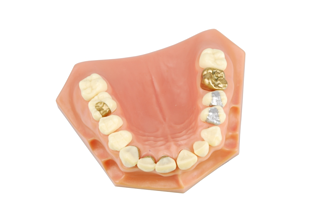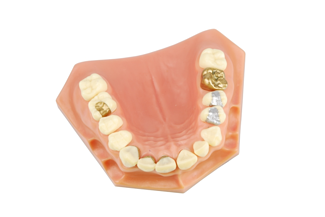White Fillings (composite) Versus Silver Fillings (amalgam)


Your dentist has told you that you have a cavity and need a filling. Your dentist only places composite resin fillings (tooth-colored or white) and does not do amalgam (metal or silver) fillings. The tooth-colored fillings are a more expensive. How do you make a good choice? Here's a brief history of fillings that will help put it in perspective.
Fillings have a long known history going back to China in 659 A.D where it has been recorded that a silver paste was being used as filling material. Before that it was stone chips, cork, lead and golf leaf. During the 19th century in France a pair of brothers invented an amalgam of silver, tin, copper, zinc and about 60% mercury. They were the ones that brought it to America in 1833. Prior to that, in America, you had your tooth removed or endured the long hard process of having softened gold hammered into the cavity. Once bought to America, everyone started using the amalgam material for dental fillings.**
In 1843 the ASDS (American Society of Dental Surgeons) stated that placing amalgam fillings would be considered malpractice and had their members sign a pledge to abstain. This was the downfall of the ASDS, Americans wanted their cheap fillings! Amalgam fillings have been linked to birth defects, neuro-degenerative disorders, mental disorders, lesions and multiple sclerosis. There are multiple environmental concerns which is why the EPA pays a visit to your dentists office twice a year to make sure they are using the proper methods to keep old amalgam residue out of your cities drinking water. All dentists must install special equipment to separate the amalgam materials and dispose of it properly.
There are other shortcomings of amalgam fillings. The way that they are placed leaves a microscopic gap between the filling and the tooth. This is where decay can develop. Bacteria collect in the space and multiply. Over time the bacteria breakdown your tooth structure and can reach your nerve. This decay could lead to needing a root canal. Composite tooth colored fillings are bonded to the tooth, they meld with your tooth structure and prevent the decay from forming underneath. Amalgam fillings can also expand and contract from temperature fluctuations and cause cracks in your teeth. If a crack is formed then more expansive dentistry is needed. You could also lose your tooth altogether.
I like to look at things from a positive point of view, so they way I reason it is this: There are NO health concerns or controversy surrounding composite resin materials, and tooth colored fillings look SO MUCH better so why would you not make the safe choice?
Composite resins look great, bond to your tooth, and have no health contraindications connected to them.
There is a cost difference, but in the long term you are saving money. You are also treating your teeth in the nest possible way.
If you have a group dental plan that doesn't cover the tooth-colored fillings on your back teeth, then contact your employer. Ask them to offer a higher option plan that covers these fillings. Insurance companies have these plans available and they are becoming more and more common.
Your dentist is working for your best interest. There is a reason why more and more dental offices do NOT carry amalgam materials.
**History of fillings: Wikipedia


